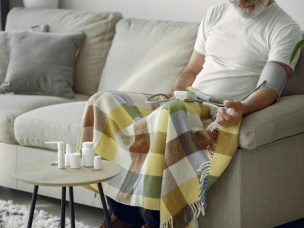In this MD Newsline exclusive interview with vitreoretinal specialist Dr. Murtaza Adam, we discuss barriers to treatment adherence and COVID-19 as they relate to wet AMD.
MD Newsline:
What are the major barriers to wet AMD treatment adherence?
Dr. Murtaza Adam:
“The first thing people think about when they go for their first appointment for wet AMD is, ‘how am I going to survive an injection in the eye?’ So it’s really difficult to explain to patients that the treatment we administer in the office, that they’re going to likely need for the rest of their lives—perhaps on a monthly or every-other-month basis—is really not painful, has minimal side effects, and is safe. Intravitreal injection is the most common medical procedure performed in the United States.
So those are the first things I say to patients. I also tell them that we do an average of anywhere from 20 to 40 injections in a single day. And our waiting room is busy because patients understand they need treatment to continue to see, and it’s not so bad that they don’t come back. They do.
We do an excellent job in our practice to minimize discomfort during and after treatment. So fear is the first barrier for patients with wet AMD. They’re fearful of treatment initially, but once they get an injection in the eye, they usually say something like the flu shot or the COVID vaccine was worse. It’s hard to believe, but it’s true most of the time.
The second barrier to treatment adherence is the burden of treatment. Wet AMD is a lifelong disease, and there is no curative treatment yet. Our patients with wet AMD usually don’t drive. They may live alone or in assisted living, and they need someone to transport them back and forth to their appointments. And they have to see their retina specialist more than they see their grandkids sometimes. So these patients have a really high burden of treatment.
I think the theme for our upcoming wet AMD drugs in the pipeline is to reduce treatment burden with sustained delivery. The more that we have access to and develop safe versions of these medicines in the future, the more compliance we’ll have. Because when it comes to treatment for wet AMD, it’s really difficult for patients and families to maintain.
One of the other barriers is these patients are old and sick and have many other medical problems. So there are other appointments they need to go to. Sometimes they’re hospitalized and are out of our office for months because of a hospitalization or a rehabilitation stay. And we’ll see them when they come back, and their vision will have dropped, their exudation is worse, and we’ll have to re-treat them to get them back on track.
So, in summary, the major treatment barriers for wet AMD are fear, treatment burden, and the other challenges that come with getting older. Those are the main barriers to treatment adherence that we deal with daily.”
MD Newsline:
Can you please share with us your survey for patients and caregivers on treatment burden and compliance?
Dr. Murtaza Adam:
“We’re currently participating in a clinical trial sponsored by a pharmaceutical company looking for the reasons for and the barriers to consistent care. For patients that have difficulty maintaining compliance, it’s really important to understand the socioeconomic factors outside of medical factors that play a role in patients being unable to maintain consistent and needed treatments to maintain the health and function of their eyes.
And so, this trial is really unique because most of the studies that we perform with pharmaceutical companies relate to a simple, biologic problem. There is a disease, and we must treat it with this drug. In our study, we’re really trying to take a comprehensive view of the patient and understand their goals. What are their motivations? What do they want out of treatment?
Because, as their physician, I want their vision to be as good as it can be, and I want their retina scans to be perfect. Those are my measures of success in clinic every day.
I have patients that have lost vision and have legal blindness, and I make sure that I ask them what their goals of treatment are. What do they need from me outside of good retinal scans and better vision? If we can help answer that question in this controlled study and that improves patient care, I think that’s going to be an amazing thing.”
MD Newsline:
What are the biggest challenges that ophthalmologists are tasked with in the wake of COVID-19?
Dr. Murtaza Adam:
“As retina specialists, we are unique in that the volume of patients that we see ranges somewhere from twice, triple, or quadruple the volume of a typical outpatient medical practice. And so, for us to keep rooms sanitized, maintain social distancing, perform all the testing that we need to do, and have patients be happy with us in maintaining safety—it’s been a really difficult but important pivot that we’ve made [since the start of the COVID-19 pandemic].
We have to be vigilant that COVID-19 might continue or resurface in the future. I think letting our guard down and saying we can go back to the ways of old probably isn’t wise. And, honestly, there are many things that I don’t think we can go back to. I don’t think patients are going to tolerate rooms not being wiped down thoroughly, and doctors not wearing gloves or masks, etc. So it’s going to be interesting to see how that all plays out.
We’ve maintained a lot of protocols that we initiated because of the pandemic. I think much of it will continue, not only to maintain the level of safety that we have now but to be prepared for the future.
It’s a really difficult thing to see 80 patients in a day and keep people distanced, but we’ve figured it out. We’ve rearranged the way that we image patients, and the workflow, and the dilation protocols—there are all kinds of things that we’ve tinkered with to maintain safety and provide a high level of quality care and meaningful time with the doctor.
Those are the things that I think are the legacy of the COVID-19 pandemic. And honestly, some of them are really good. I’m grateful for them. For example, I used to never wear a mask when I injected a patient, and there is good data out there that show that if you don’t speak immediately before an injection or you wear a mask before an injection, your risk of contaminating the field and causing an endophthalmitis significantly drops.
I used to never wear a mask, and I used to have difficulty having the patient not talk and having myself not talk during an injection. You want to have a conversation with a patient and maintain that personal connection during treatment. Now, I can wear a mask and feel safe while chatting with them and giving them instructions. Good and bad things have come out of this pandemic. I’m thankful for the good.”
Responses have been condensed and lightly edited.









